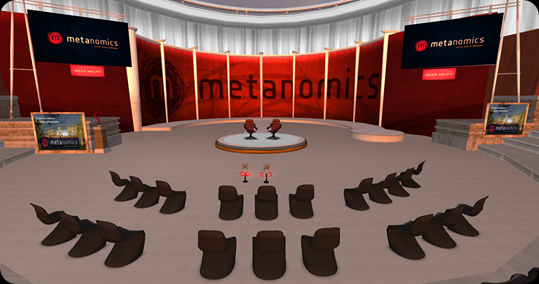Written By: Will Burns | Andromeda Media Group
SecondLife: Aeonix Aeon | Pixel Labs
Twitter: http://www.twitter.com/darianknight
What starts as a trickle at the dam, soon widens into a stream of clarity.
 Philip Rosedale | Interim CEO of Linden Lab
Philip Rosedale | Interim CEO of Linden Lab
I was greeted recently by a friend in Second Life asking me what my thoughts are on the recent rumors surrounding a possible bid by Microsoft to acquire Linden Lab and all of its holdings. When I replied that I had heard no such rumors, she stood in shock that I, a person usually keen on these inner workings, had not been keeping up with the latest information and rumors.
To be fair, when I see these sorts of rumors floating around, I usually sit tight and see how it weighs out over a period of time before I make any definitive comments in either direction. In this case, I chose the 40 Days and 40 Nights timeframe as the title of this article as an indication of how long it would take to know for certain what was going on. Aside from that, such an acquisition would prove to be of Biblical proportions if Microsoft were involved.
Like all good rumors, there is some manner of truth at the core to suggest that such a thing could be possible, and with this latest rumor there is no doubt that the scenario in question is very plausible. I had made the prediction concerning a possible buyout or IPO on behalf of Linden Lab around April of 2010, when Mark Kingdon was still at the helm based on the telltale signs one would expect from a company in the position that Linden Lab was in.
For a company such as Linden Research, or Linden Lab as we know them, we have a company who is reaching the end of an investor lifecycle. If we look back around 2002 to 2005, the current lifecycle of investments are reaching (or have reached) their course and one would expect that the board of directors would be impatiently reminding Mr. Kingdon and now Mr. Rosedale that the devil is about to come for their souls.
Concerning the prior, the change over from Mark Kingdon back to Philip Rosedale, it makes perfect sense in the scope of the situation. Which is to say that being on the board of directors in an advisory fashion during that time, Mr. Rosedale understood that the investment cycle was nearing an end and that the exit strategy of any technology company often times is either to push for an IPO filing or to court a complete acquisition (buy out). It also makes a lot of sense that Philip Rosedale would make the assertion that he is the “Interim CEO” and not just the CEO of Linden Lab, because this is an indication that he (and the board of directors) see this phase as a very temporary one, which will be remedied through a buyout or IPO.
When Mr Kingdon was unable to sustain or grow the company during his time, one would expect that the board of directors grew anxious with how the company was being run and where Mark was taking it (pushing for social media and web), which is in stark contrast to what a system like Second Life is about. This, of course, raised a lot of concern not just with the board of directors but also the community as a whole which led to widespread backlash over the actions of Mark Kingdon and a growing disdain for Second Life and its direction.
While it was said many times by Mr Kingdon that Second Life was indeed profitable, I saw a little deeper into those statements than the average person would and took some time to email Mr Kingdon my reply:
It is not what you are saying publically that concerns me. It is what you are deliberately not saying publically which is of interest. I have no doubt that Second Life is not in the red, but I suspect there will be widespread cuts and drastic changes coming in order that this situation remain truthful.
As of that time, the missing link in my mind was that the actions of the company and employees were speaking volumes of truth versus the public statements being made and in light of those actions, I could only interpret it as a chain of events that I am very familiar with in the technology industry.
Essentially, Linden Lab is at the end of that lifecycle of investment and for those of us who are knowledgeable on this, we also know what sorts of things to expect in the actions of a company in this position.
Years ago, I’ve been in the same sort of position. A group of investors are more than eager to put money into a company or startup but usually want a very high return at the end of a lifecycle, which is usually set between 3 to 5 years. What that means, is that the moment you take the investment, the clock starts ticking against you. Sure you’ll be partying and celebrating the day the first investment check clears, but trust me when I say that by year 4 you’ll begin to worry and by year 5 you’ll be panicking.
Back to Linden Lab, however, and we see the same sorts of behavioral patterns of a company reaching the end of that lifecycle. The odds are high that the investors of that company are now tapping their feet and asking when they’ll be getting their ROI (return on investment), and to that note it can be said that often times the ROI for a technology startup can be quite steep to say the least.
For a company such as Linden Lab, one can expect that at the end of the lifecycle they would begin acting in (what would be seen by an outsider) very nonsensical manners, with massive layoffs, external office closings, and liquidation of assets in an attempt to bring the company into a leaner and more profitable state. This behavior is also a telltale sign that reorganization in the company is to position that company for the exit strategy of IPO or Buyout from a bigger corporation.
During this time we would also expect such a company to rebrand as well as redesign its product drastically in an effort to garner a wider appeal outside of its niche’ audience. Not to mention a sudden interest in rapid development in their product, (Agile Development, anyone?)
When we look back at Linden Lab, we see that indeed all of this is happening. Liquidation of assets such as the closing of the Teen Grid, 30% reduction in staff, massive rebranding and redesign of their viewer in an attempt to appeal to a market outside of its niche’, the acquisition and closing down of AvatarsUnited, and of course the hiring of a high profile Marketing VP from Activision/Blizzard entertainment to add to their roster and bolster their appeal for a buyout.
The closing of the UK office (and probably others) is also a strong indication that this is exactly the position that Linden Lab is in today.
A number of months ago, I was asked whether I was glad to see Philip Rosedale back at the helm, and for awhile I remained quiet. I’ll tell you here, that the conversation frightened the other person, first in my silence (because I am only ever quiet with such answers when I know something very deep is happening and I am trying to figure out how best to word it as not to create panic), and secondly at the answer I did eventually give her.
The answer I eventually did give was that Philip Rosedale was not the perceived “savior” of Second Life this time around. While everyone rejoiced at his return, I instead began to worry. It isn’t that I do not believe Philip Rosedale is not attempting to do what is best for the community he started, but instead I worry because he may be in a position where he will have to make a very hard decision in order to keep this alive.
“Finally!” people would say, “With Phil back in charge, Second Life will get back on track and return to its glory days!”
Little did people know, that this time around Philip is not the savior but the wolf in sheep’s clothing. He’s not back to cater to the whims of the community and return to the way things were in the early days. He’s back to execute the task that Mr Kingdon could not.
Which is to say, that Philip Rosedale is charged with the execution of bringing Second Life and Linden Lab (Linden Research) to its exit strategy by making the company lucrative for a buyout or IPO in order that the investors (and himself) can cash out and receive the massive ROI in the process.
Does this scare you?
I’d say with confidence that Second Life is not in a position to reach an IPO status, but the actions of the company dictate that they are preparing for their exit strategy. This leaves the only option on the table, acquisition.
It’s either an acquisition or the very likelihood that Second Life will cease to exist in the future. This is the sort of hard decision that Philip is trying to balance right now, and in the process he is making provisions that the community will not lose out in the transition. There will be a transitory period, no doubt… which is why he has spoken of a new time in the history of Second
Life.
If you’ve been paying attention, he’s been telling you all along.
In so much as the rumor that Microsoft has made a quiet bid for complete acquisition, this would not surprise me. From what I know, Microsoft has had quite a lot of involvement in the ReactionGrid and (I’m a bit fuzzy on this) to the point of direct involvement with coding. It would not surprise me if in the course of opening up bids for acquisition of Linden Lab that Microsoft may have sent a preliminary bid. This does not, however, indicate that Microsoft will actually purchase Linden Lab.
Major corporations are known for investigating possible technology acquisitions on a regular basis, and as such a corporation such as Microsoft would of course put in a preliminary bid on the technology holdings of Linden Lab as a matter of putting out “feelers”. Whether or not this develops into something bigger is another issue altogether, and I cannot really say one way or the other what will happen.
So, of course, rumors do have a way of being based in concrete reality. Whether the rumor of Microsoft placing a bid on the complete acquisition of Linden Lab is truthful or not isn’t the issue at hand, but whether Linden Lab is actively in a position to be seeking that exit strategy to begin with. In this case, we can say that yes, indeed, Linden Lab is in a situation where they are pursuing an acquisition exit strategy (as opposed to an IPO), and in light of this information I’m sure there have been other bids crossing the desk of Philip Rosedale from other Fortune 500 companies.
If Microsoft had not made that bid for complete acquisition, Linden Lab would have officially denied it publically as would Microsoft. We shouldn’t rule that out at this point because such an official statement is just as likely in the next 40 days, but if we see an outright denial after this initial ambiguity and silence, it is likely to mean that yes Microsoft did make a bid but it did not pan out.
Why would companies take this stance?
If Microsoft makes a bid on Linden Lab but the details never materialized, it’s in the best interest of both companies to save face and deny they ever were in talks to begin with. It is also in the best interest of both companies involved to deny there are talks to begin with even if they are in talks and negotiations, mainly because should that information be officially let out to the public, Microsoft would see a surge in stock prices for the time being, and the valuation of Second Life would also temporarily soar.
But if those negotiations faltered publically, Microsoft would not lose anything from it while Linden Lab would plummet in valuation as a result, making it that much harder to court potential acquisition.
So you see, it is in the best interest of both companies to remain silent on this subject until such time as negotiations are actually finalized. You and I wouldn’t know that Linden Research is a subsidiary of Microsoft until the day it actually is finalized. At least, not officially.
But what about this rumor?
As I’ve said on my twitter, it’s just a rumor and everyone should dig a little deeper if we are to really know what it going on. I would not say it is implausible, because I understand the situation at Linden Lab a bit better than I let on. By trade I am a technology forecaster and virtual environment expert, which is really just a fancy way of saying I have been around many years in this industry; enough to be able to spot when trends are surfacing and likely to resurface.
In the case of Linden Lab and Microsoft, I wouldn’t put it past them to have put an offer of acquisition on the table, and it is very likely they have done so since Linden Lab is pursuing the acquisition exit strategy. So in light of this rumor, I’d say there is about an 75% probability this is true.
Regardless, I believe that we’ll know more about the situation over the next 40 days and whether we’ll be able to say with 100% accuracy that this is either true of false concerning Microsoft.
Until then, keep in mind that regardless of the outcome of this rumor, Linden Lab knows that it’s time to pay the devil its due. Whether or not we find that the devil we thought was behind it is truly the devil or just a lower demon compared to the bigger devil of Microsoft, has yet to be confirmed.
Let us hope that they aren’t looking to sell all of our souls in the process.












